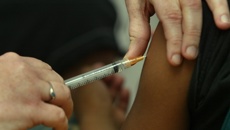Experts are proposing a smarter way to gauge Covid-19′s spread in New Zealand, as a highly mutated new subvariant puts global health authorities on high alert.
Just days after New Zealand scrapped the last of its Covid-19 protections, scientists have been closely tracking the new Omicron type BA.2.86, nicknamed Pirola, whose 36 mutations sets it well apart from its closest relative.
While it’s been detected in just a handful of countries so far, the World Health Organisation has designated it a “variant under monitoring”, amid growing concern it represents a large enough evolutionary leap to drive new waves.
“There are two really important questions with this variant,” Covid-19 modeller Professor Michael Plank told the Herald.
“One is the growth rate: if it doesn’t or can’t compete with variants that are currently in circulation, then it’s not going to have much of an impact.”
For around a year now, the coronavirus circulating in New Zealand has been made up of a “soup” of Omicron subvariants.
More recently, a succession of “recombinant” lineages classified as XBB, each packing some immune-evasion advantage, have emerged dominant.
But none have managed to trigger any major new surges in a population that’s now highly exposed to – and vaccinated against – the virus.
“The second one is, if it does have the legs to take off, then what does the severity look like?” Plank said.
“That’s a harder question to answer – or will at least take longer to do – because estimating severity is difficult without a reliable estimate of the number of infections.
“Because, while you might see a rise in hospital numbers, you don’t really know whether that’s an increase in the number of infections, or there’s actually a genuine increase in severity.”
The UK Health Security Agency’s initial risk assessment also concluded that, based on the few confirmed cases so far, it was too early to make a call on Pirola’s severity.
The agency did, however, suggest there was now “established international transmission”, along with potential for rapid growth, at a time another Omicron off-shoot, EG.5 or “Eris”, has been fuelling rises in case and hospitalisation rates in the US.
On Pirola’s striking number of mutations, again, the UK agency said it was too soon to predict what this meant for impact – but added there was “sufficient information to expect significant antigenic change”.
Like his counterparts around the world, Plank expected we were only now seeing the tip of Pirola’s iceberg.
“It’s certainly a reminder that we need surveillance – including genomic surveillance - to keep an eye out for new variants that could really have an impact.”
That comes at a time New Zealand’s reported cases had dropped off by about 40 per cent over the week since the Government announced an end to the requirement for infected people to isolate for seven days.
Even before that change, Plank estimated the ratio of cases picked up or reported versus total overall infections – something called the case ascertainment rate of CAR – sat somewhere between one in three and one in four.
While the fraction of reported infections had been clearly falling over time, Plank said the numbers could still be useful for surveillance.
“If we see those reported case numbers growing rapidly, that’s potentially an early warning signal that could translate into significant demand on healthcare systems.”
Having decided to scrap repeatedly-delayed plans for a permanent infection prevalence survey, health authorities continue to rely on a mix of wastewater-based surveillance and community and hospital-level case reporting and sampling.
In a new Government-funded study, released online ahead of peer review, Plank and others propose a new statistical model that combines those different indicators to give an overall picture of infection rates in the population.
That included giving the CAR at any point in time, along with the effective reproduction number, or Reff, which represented the average number of people a given infected person was likely to pass the virus onto.
/cloudfront-ap-southeast-2.images.arcpublishing.com/nzme/DJKDB7ILDZHX7GGNWUV3U4S7NA.jpg) Covid-19 modeller Professor Michael Plank.
Covid-19 modeller Professor Michael Plank.
With Covid-19 rates running far lower than this time a year ago, but growing slowly again, modellers estimate the current Reff stands at just above one.
Fellow study author and University of Canterbury researcher Dr Leighton Watson said the model could be applied nationally or regionally, and used by any country where most people were connected to the wastewater system.
“While the results are not the only piece to the puzzle, the model could be used as an additional source of information to inform public health policy decisions and hospital capacity planning.”
Watson said this approach took into account the fact that restrictions and testing guidelines had eased dramatically since Omicron first washed over the country 18 months ago.
“At first, people would test every time they got a sore throat,” he said.
“Anecdotally, now it seems like many people are assuming they are just under the weather because, for example, their kids bring every single bug possible home from school.”
/cloudfront-ap-southeast-2.images.arcpublishing.com/nzme/45R2R2CJVPXYBYVKSEIIFMJSKI.jpg) Wastewater surveillance has been crucial in gauging Covid-19's prevalence in New Zealand.
Wastewater surveillance has been crucial in gauging Covid-19's prevalence in New Zealand.
Fewer cases could mean fewer infections or fewer people reporting - and the difference was crucial to understand.
In their study, the researchers used their new model to demonstrate that, while reported case numbers made 2022′s first wave appear twice as large as the winter wave a few months later, the true numbers of infections in both surges were actually similar.
Plank said the study highlighted the value of keeping wastewater surveillance running, in an environment where fewer people were testing.
“Everyone who lives somewhere that’s linked up to the town wastewater system is going to shed the virus into the wastewater if they have Covid,” Watson added.
“If they are plumbed into the wastewater system and we are sampling it, we can pick that up independent of whether people are testing or not.”
Over the longer term, there remained many troubling unknowns about Covid-19 and its potential to drive fresh waves, kill or hospitalise more people, or widen the number of people left suffering ongoing symptoms.
“Unlike something like the flu, we don’t really have a clear sense of how Covid is going to behave,” Plank said.
“For instance, are we going to get one wave in winter, or will we continue to see three or four waves at different times of the year?
“So, we really just need to have that picture of the health burden that it’s creating, so we can respond accordingly.”
Take your Radio, Podcasts and Music with you









